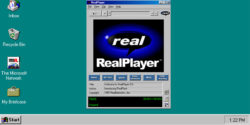In part two of his history of internet radio, Dom Robinson covers RealAudio, the technology that pushed streaming internet audio into the mainstream, years ahead of video. He talks with Dave Mallinson, an early employee at Progressive Networks – which would become RealNetworks – who discusses the delicate balance between getting good enough sound quality using only enough bandwidth as was absolutely necessary.
But the big get is founder Rob Glaser, who recalls his camp counselor who was a college radio DJ and the intercom-based station he set up in his high school. Glaser says his company started with audio because, in 1995 he thought, “‘It will take years if we start on video’ (because of the bandwidth). Given dial-up adoption was typically around 14.4Kbps, I thought voice-quality audio would be a good starting point.”
Reflecting on the impact of internet radio, Glaser writes,
It made everything global. Everyone could be a broadcaster, and everyone could listen. It took radio out of the niche. It has dramatically exploded the enthusiasm for broadcasting….
For me, internet radio exposes you to so many choices. I lament the fact that modern social media distribution systems restrict things as a mindshare matter (not a technical matter). Somehow the social networks have tribalized us, which is a shame, since the proliferation of internet radio offers us so much more choice than we had before.
Even though RealNetworks is no longer a significant player in online streaming media, one cannot underestimate the role the company played in establishing practical audio and video transmission on the internet. Though we take them for granted now, they were true technical accomplishments in the late 90s, when most home internet connections had just a fraction of the speed that your typical mobile data network provides.
RealAudio runs deep in my own history. I started experimenting with a RealAudio server around 1996 while working at a university media lab. At that time RealNetworks gave away a version of their server software for free if you only intended to broadcast a limited number of streams, along with free encoding apps. It’s hard to explain the rush of setting up your first functioning live internet stream.
Starting in 2000 I led an effort to digitize hundreds of hours of foreign language learning tapes and make them available to students online. At the same time I began working with some forward-thinking faculty to record instructional video that we also streamed via RealVideo to students who had campus network access in their dorms or in computer labs.
By the mid-2000s our campus adopted RealAudio and RealVideo as a standard so that different units across campus could more easily pool resources and we could support streaming big live events like graduation. But by the end of the decade things shifted to audio and video that you could play in your web browser, without needing a special application or plug-in like RealPlayer, Windows Media Player or Quicktime, even though the latter two apps live on as part of the Windows and Mac OS operating systems, respectively.
During the height of the streaming media wars, circa 2006, trying to watch or listen to different programming online often meant having three or more different apps installed. Or it meant every site had to support three different kinds of streams. It could be quite a pain.
The rise of Shoutcast and MP3 streaming had already started to displace the multi-player confusion for internet radio by the time that YouTube came on the scene and acclimated a generation of online video watchers to browser-based experience. Note that smartphones were still a couple of years away.
RealNetworks is an example of how the first-mover advantage is not necessarily a lasting one. While RealAudio was pioneering technology, it was also a closed platform, owned and controlled by a single company. There was no way for other people or companies to create new applications for it, or improve upon it. The same was true of Microsoft’s entry, Windows Media, and the Adobe Flash-based system that supplanted both by 2010.
By comparison, today’s major streaming platforms are based on open protocols and technologies. The browser on your computer is built to play audio or video without having to download apps or add plug-ins, and you don’t have to give a single thought to what format its in. No doubt, it’s an improvement. But it all had to start somewhere.
I’ll end with a shameless plug. Dom also talked with me for his part two article, letting me go on about how internet radio gave a particular advantage to non-commercial radio in the U.S.
Learn more about the early years of internet radio (and proto-podcasting) in the first part of Dom’s series, marking the 25th anniversary of the medium. I also talked with Dom for a recent episode of our podcast, and separately I shared my own thoughts on those early days, including how 1993 internet radio saved podcasting in 2018.
If you really want to get into the wayback machine, you can read my thoughts on RealAudio from 2010, on the occasion of Glaser stepping down as the company’s CEO.



